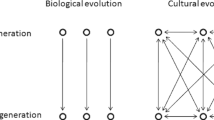Abstract
The word ‘meme’ was first used by Richard Dawkins (Dawkins, 1976)1 in the sense of a replicator to introduce the idea of cultural transmission through the process of imitation, just as genes are responsible for the evolution of organisms. Following Dawkins several writers came forth to have a closer look at ‘meme’. The consensus was that this was a fascinating way of explaining cultural evolution and transmission; that meme is the basic unit of (cultural) information whose existence influences events so as to make more copies of itself (Brodie, 1996).2 The book which got most attention in this line of literature wasThe Meme Machine (Blackmore, 1993),3 which favours the idea that culture, like biology, evolves through the process of variation, selection and replication. Something striking in Blackmore’s thesis is that emotions and attitudes do not count as memes since they are subjective and never get passed on.
Similar content being viewed by others
Author information
Authors and Affiliations
Rights and permissions
About this article
Cite this article
Menon, S. The selfish meme & the selflessATMA . SOPHIA 41, 83–88 (2002). https://doi.org/10.1007/BF02780405
Issue Date:
DOI: https://doi.org/10.1007/BF02780405




